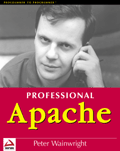 Apache server is easily the most popular platform for serving Web sites on the Internet today. And while I’ll be the first to say that it’s refreshing to see a product of the open source movement be the popular choice, rather than the popular alternative, I just wish it wasn’t so darned difficult to use! As Peter Wainwright shows in this book, it doesn’t have to be.
Apache server is easily the most popular platform for serving Web sites on the Internet today. And while I’ll be the first to say that it’s refreshing to see a product of the open source movement be the popular choice, rather than the popular alternative, I just wish it wasn’t so darned difficult to use! As Peter Wainwright shows in this book, it doesn’t have to be.
The great strength of Apache is in its limitless capacity to be configured and expanded to fit any need. As anyone who has had to come to grips with a stock-standard Apache installation in need of configuration will tell you, this is also its downfall. Trying to learn how to use Apache by reading the online reference is like trying to learn to speak English by reading the dictionary. The online reference is just that – a reference to all the commands and configuration directives that Apache will recognize. Actually assembling that mass of command descriptions into a working understanding of the program is next to impossible. Isn’t there a manual somewhere that users can turn to for help in learning how to use this amazing piece of software? Well… there is now.
In the author’s words: “this book aims to take you beyond the online documentation and books describing lists of Apache directives, and give you the information you need to take control of your web server.” And in that goal, this book succeeds in stellar fashion.
 The first half of the book deals with the basics: setting up Apache to work the way you need it to. It covers everything from an introduction to the Internet and its protocols, which is easy to follow and technically accurate aside from a couple of flubbed acronyms (TCP/IP does not stand for “Transport Communication Protocol” and UDP is not the “Unigram Data Protocol”), to configuration of Server Side Includes (SSI) and scripting languages for delivering dynamic content. Along the way, all of Apache’s main configuration directives are illustrated with copious examples.
The first half of the book deals with the basics: setting up Apache to work the way you need it to. It covers everything from an introduction to the Internet and its protocols, which is easy to follow and technically accurate aside from a couple of flubbed acronyms (TCP/IP does not stand for “Transport Communication Protocol” and UDP is not the “Unigram Data Protocol”), to configuration of Server Side Includes (SSI) and scripting languages for delivering dynamic content. Along the way, all of Apache’s main configuration directives are illustrated with copious examples.
The second half of the book deals with the two very large topics of performance tuning and server security. In sharp contrast to the glossed-over treatment these topics tend to get in other books and online tutorials, the author goes into considerable depth in such issues as tweaking Apache’s performance, setting up proxy servers and caching, improving fault tolerance with clustered servers, monitoring Apache’s activity logs, and setting up an SSL server (I’ve been looking for a good guide to this for ages!).
To put this book through its paces, I decided that I would attempt to set up a virtual host on my Web server – something that, until now, I had not the foggiest notion of how to do. Well, not only did this book walk me through the process of setting up name-based virtual hosts in detail, but it also presented me with several alternative solutions that I might have considered if I were going for a more robust solution, namely multiple server instances and IP-based virtual hosts. The discussion of dynamic virtual hosting that capped off the chapter knocked my socks off!
Although you might think the cover price is a little steep at US$49.99, the sheer power unlocked by this book is worth so much more than that. Whether you work with an Apache server on a daily basis or are just setting it up for the first time, “Professional Apache” is an indispensable tool that you really can’t afford to be without.
“Professional Apache” by Peter Wainwright
1999 WROX Press (www.wrox.com)
486 pages + 99 pages of Appendices
Rating: 5/5
Buy it at Amazon.com for $39.99
 Kevin Yank
Kevin YankKevin Yank is an accomplished web developer, speaker, trainer and author of Build Your Own Database Driven Website Using PHP & MySQL and Co-Author of Simply JavaScript and Everything You Know About CSS is Wrong! Kevin loves to share his wealth of knowledge and it didn't stop at books, he's also the course instructor to 3 online courses in web development. Currently Kevin is the Director of Front End Engineering at Culture Amp.

